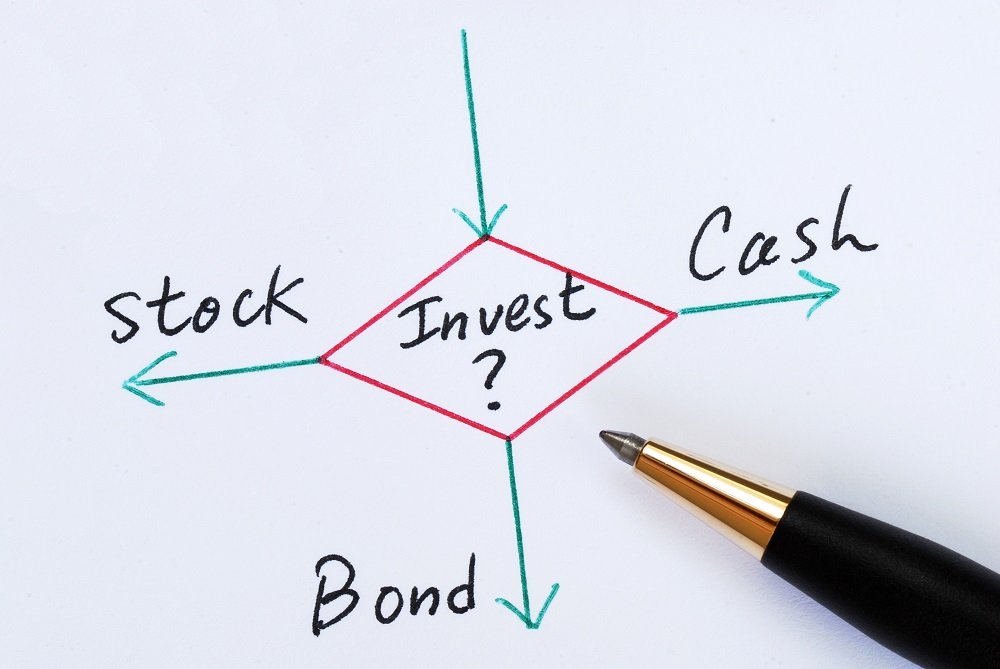What is the 60/40 Portfolio?
The 60/40 Portfolio is and has been the standard recommendation by financial advisors far and wide to build a generic moderate or ‘average’ risk portfolio. 60% of its construction is made up from U.S. Large Cap Stocks and the other 40% should be considered investment grade bonds. This mix has been considered what professionals mean when they say, ‘diversified portfolio.’
Basically, as a retail investor, if you had no specific requirements with a chunk of money you were looking to invest, the 60/40 Portfolio would have been the recommendation.
The 60/40 Portfolio was an average way of approaching investing. Retirement target date funds are often a variation of the 60/40 Portfolio with the percentages tilting towards bonds as the retirement year gets closer and some emerging markets sprinkled in on top.
In this article, I’ll give you an idea of who has traditionally invested in the 60/40 Portfolio and if it’s worth considering given today’s investment environment.

In this Article
The Difference Between Stocks and Bonds
Understanding the 60/40 Portfolio also requires understanding what the difference is between a stock and bond and why splitting your portfolio among the two may be considered preferable to holding only a single asset class.
Debt vs. Equity
A stock is considered equity. When you buy a stock, you own a share of a piece of a company. When that share was originally issued, the price paid by the original investor paid the company and the company used it as part of its balance sheet. Future price fluctuations in the stock price do not benefit the company’s finances directly.
A bond, on the other hand, is considered debt. When you are issued a bond then you are lending your money to the company. This company owes you that money back plus interest over a specified period at a specified interest rate.
Fixed Income vs. Capital Gains
A stock rises in value or falls in value based on supply and demand by investors. An investor earns or loses money on their stock by that price appreciating (going up) or depreciating (going down).
The amount earned or lost is realized when the stock is sold. When this happens the resulting profit or loss is considered a capital gain or loss. Additionally, these capital gains and losses are taxed in a specific manner by the IRS depending on if you held it longer than a year (long-term) or less than a year (short-term).
Bonds, differ from stocks. A bond pays out at a specific interest rate plus the initial amount lent over the period. This interest payment made to you is stable and will continue in perpetuity based on the conditions of the issuance… thus it is considered fixed income.
When One Goes Up the Other… goes Down (Probably)
The pairing of stocks and bonds is often seen as beneficial due to their somewhat inverse relationship.
When one goes up the other goes down and vice versa. Since stocks are considered riskier, when the markets hit a downturn folks flee towards fixed income since they know they can count on a specific return resulting in bond prices going up.
It should be noted that this inverse relationship is not exact.
It may not happen at shorter time frames, but this relationship does hold up well when your time horizon is long. For example, the relationship may not hold during a single down day in the equity market but will generally work for larger and longer fluctuations in market activity.
Who uses the 60/40 Portfolio?
The 60/40 Portfolio has generally been considered a simple, but robust way to construct a portfolio. Thus, it has been advocated by many DIY investors and personal finance gurus. More sophisticated portfolios are usually generated by financial advisors; however, some sort of stock and bond split is usually the starting point they work from.
What are the other options?
The other options that compete with the 60/40 portfolio include the 80/20 portfolio and Target Date Funds.
The 80/20 portfolio is exactly like the 60/40 except that 80% of the portfolio is generated from US Equities and 20% from investment grade bonds. The reason folks may choose an 80/20 mix over a 60/40 mix is the increase in exposure to stocks and thus risk.
If future market performance is expected to be muted it may be considered necessary to get a higher exposure to risk in hopes for better returns.
Target Date Funds are often composed of even more equities than those just found in the US Markets. They usually have some type of foreign / emerging market exposure which is considered riskier than US Markets.
Additionally, Target Date Funds’ bond and equity mix often changes over times as the current date progresses closer to the target date.
If the target year is your expected retirement year, theoretically you would want less exposure to risk when compared to a much younger self… thus the bond allocation near the target is likely considerably higher.
Are Bonds are expected to Go Down?
No one knows the answer to this question for sure.
What can be said, however, is that rates are at historical lows… however this has been much the case over the last 30 years. Whenever the Federal Reserve is expected to increase rates the value of bonds go down… thus if the Fed is expected to raise rates anytime soon then yes you could expect the value of bonds to go down.
But! If any type of market calamity occurs, the Fed usually lowers rates. These types of calamities are usually unpredictable and the exact reason why a person would have exposure to bonds in the first place.
Thus, if you can predict the future price of bonds, you will be very rich. However, if you acknowledge the entire point in diversifying is because you failed fortune telling school then you should also recognize that the price of bonds may go up or down… who knows? I don’t… and neither does anyone else.
How Has Diversifying with 60/40 Performed?
Understanding how a 60/40 Portfolio has performed over the years requires a benchmark. We need a measuring stick to compare to something else. For specific purposes of this article, I will choose the S&P 500 as a benchmark. Returns on the ETF with ticker symbol SPY is widely used to account for the successes and failures of the S&P 500.
For the 60/40 Bond Portfolio, Vanguard has an excellent ETF that rolls this mix into a single package. The ticker symbol is VBAIX and the fund’s name is Vanguard Balanced Index Fund Institutional Shares. The Beta for VBAIX is .6.
This means that its volatility is about 60% of the overall market… and thus are risk is factored by this amount and so are our returns. We should expect returns that are about 60% less. From the date this article was published the average annual performance of VBAIX was 11.23% and the SPY was 16.60%.
Given this information we should have expected a return of 9.96%… but we achieved 11.23%.
This means that given the risk taken, the 60/40 allocation can perform better. However, if your goal is total return with high risk then you would have been better served with the S&P 500 or something else entirely. Which one you choose really depends on your ability to take on risk and what your time horizon is before you will need to use the funds.
Is the 60/40 Portfolio Dead?
If you were to google the 60/40 Portfolio you would be greeted by large numbers of articles proclaiming that the 60/40 portfolio is dead… or alive… or replaced!
The fact is that a 60/40 blend is not a panacea for creating a portfolio. What was once a solid investment mix for anyone looking to manage their own investments has become a more specific recommendation with certain time and risk constraints.
So, no, the 60/40 portfolio is not dead. It just should be viewed as a tool to be used during specific situations.
How to build your own 60/40 Portfolio
To make this simple, you can’t go wrong with the above-mentioned fund VBAIX from Vanguard. With an expense ratio of only 0.06% the fund is essentially managed for free and you can use a single stock ticker to enter the position. But, the minimum investment is a cool $5 million. Thus, VBIAX (very similar ticker!) is for you… it only has a $3,000 minimum and an expense ratio of 0.07% which is negligible.
What makes using this fund even easier is that Vanguard automatically keeps it balanced. As the underlying stocks or bonds become over or underweight, they are sold or purchased to keep a balance. I should note that I receive no compensation for touting VBIAX’s stellar features… they couldn’t afford to compensate people anyway since their ratio is so low!
Rebalancing a 60/40 Portfolio
If you decide to go another route than VBAIX then you will want to make sure that you rebalance your portfolio to keep the same mix approximately annually. There is no real reason to do it more often. If you are rebalancing in a taxable brokerage, you may also want to consider that there may be tax consequences associated with rebalancing.
Do Your Research
I write this article as an expression of my opinion. No part of this article should be considered a recommendation to buy or do anything. You should do your own research about these types of things that includes the consultation of professionals that you pay for. Afterall advice is probably worth whatever you paid for it.
Summary
In summary, there are several ways to build a successful portfolio that takes advantage of diversification. A portfolio comprising of 60% U.S. Based Equities and 50% Investment Grade Bonds is a great way to reduce risk when compared to a portfolio of 100% equities. The ups and downs will be smoother but that will come at a cost of overall return over the long term.
All that said, the 60/40 Portfolio is not dead. It has a place for those who are looking for moderate risk and moderate reward. If you are ambitious and have a long time horizon then this may not be the allocation you are looking for.
However, if you are nearing retirement and / or don’t have the stomach for large swings in your account balances then the 60/40 Portfolio just might make sense for you. I hope you enjoyed this article! Throw your comments down below if you have any thoughts on this topic.
Guy Money
As a formally trained Data Scientist I find excitement in writing about Personal Finance and how to view it through a lens filtered by data. I am excited about helping others build financial moats while at the same time helping to make the world a more livable and friendly place.



